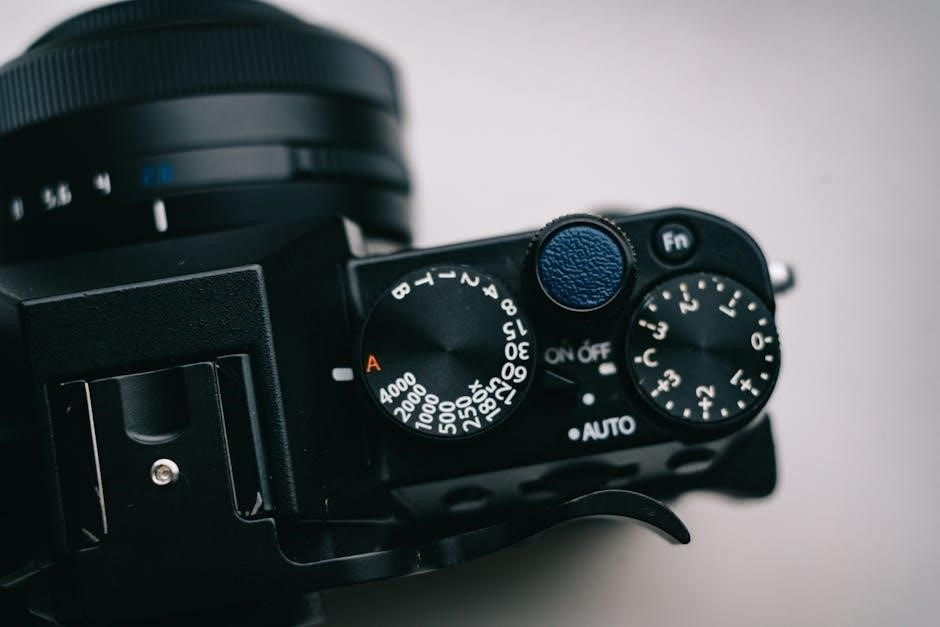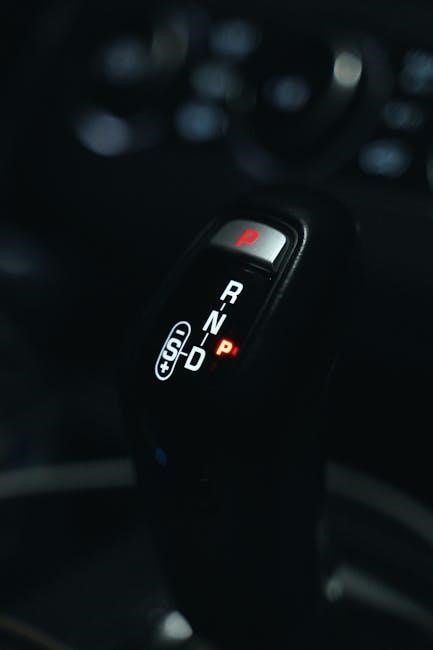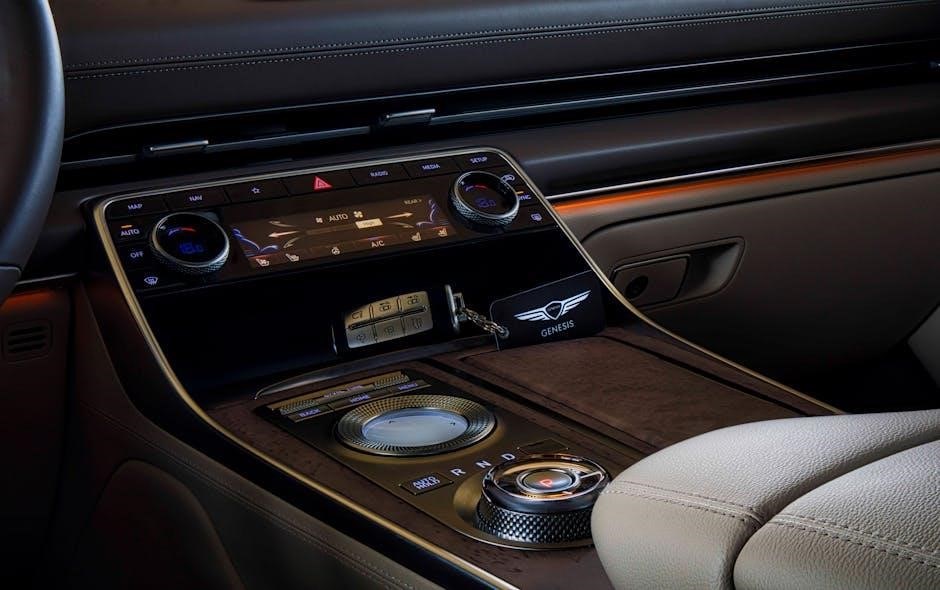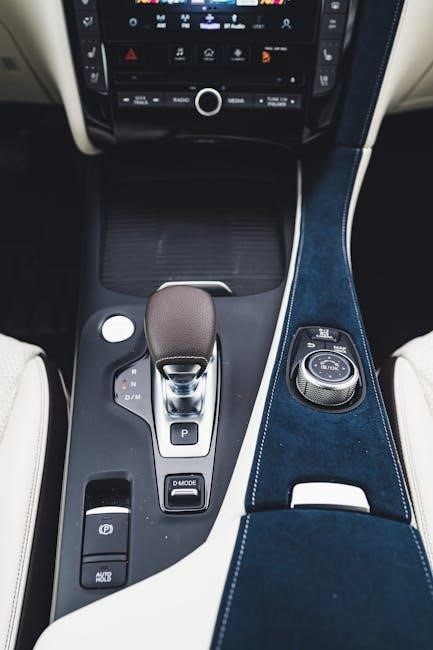Converting a manual to an automatic transmission offers increased comfort and ease of driving, though it requires careful planning and expertise due to its complexity and cost.
Why Convert a Manual to an Automatic Transmission?
Converting a manual to an automatic transmission offers enhanced comfort, reduced driver fatigue, and a smoother driving experience, especially in heavy traffic conditions. It eliminates the need for constant gear shifting, making urban commutes less stressful. Automatic transmissions also provide easier functionality, appealing to those who prefer a hassle-free driving experience. Additionally, it can reduce maintenance costs over time by minimizing wear on the clutch and other manual components. This conversion is ideal for drivers seeking convenience without sacrificing performance, making it a popular choice for modernizing older vehicles or adapting to changing driving preferences.
Overview of the Conversion Process
Converting a manual to an automatic transmission involves replacing the manual gearbox with an automatic transmission system. This process includes swapping the transmission, adjusting the engine’s wiring harness, and modifying the vehicle’s electrical system to accommodate the new components. Additionally, the clutch pedal is removed, and the throttle system may need recalibration. The conversion requires specialized tools and expertise, as it involves intricate mechanical and electrical adjustments. While it can be rewarding, the complexity and cost often make it a challenging undertaking, typically recommended for experienced professionals or dedicated enthusiasts. Proper planning and execution are essential to ensure a smooth and functional transition to an automatic transmission system.

Assessing Feasibility
Evaluating your vehicle’s suitability for manual to automatic conversion involves considering costs, technical challenges, and legal compliance. Professional expertise is often required to ensure a successful transition.
Is My Vehicle Suitable for Conversion?
Determining if your vehicle is suitable for manual to automatic conversion involves evaluating its make, model, and year. Modern cars, especially those post-1995, often require extensive modifications due to complex electrical systems. The compatibility of the transmission with your vehicle’s engine and chassis is crucial. Additionally, the cost and availability of conversion kits or replacement parts play a significant role. Some vehicles may have aftermarket solutions, while others might require custom fabrication. It’s essential to consult a professional to assess your car’s specific needs and ensure a smooth transition. Older models might be more straightforward, but newer ones often present more challenges due to advanced technology integration.
Understanding the Technical Challenges
Converting a manual to an automatic transmission involves significant technical hurdles. Beyond simply swapping the transmission, the process requires extensive modifications to the vehicle’s electrical system, including updates to the ECU and wiring harness. The engine’s computer must be reprogrammed to function with the automatic transmission, and components like the torque converter and drivetrain may need adjustment. Additionally, the cooling system may require upgrades to handle the increased heat generated by the automatic transmission. These complexities demand specialized tools and expertise, making it a challenging project for novices. Professional consultation and installation are highly recommended to ensure compatibility and smooth operation post-conversion.

Cost Considerations
Converting a manual to an automatic transmission can range from $1,000 to $3,000 for labor and parts, though costs may vary depending on the vehicle and transmission type.
Estimated Cost of Conversion
The cost of converting a manual transmission to an automatic can range from $1,000 to $3,000, depending on the vehicle and transmission type. Premium systems may exceed $5,000. Additional expenses include labor costs, which can add $500 to $2,000, depending on complexity. Factors influencing cost include the transmission kit, torque converter, and electrical modifications. High-performance or specialized transmissions may increase prices further. Budgeting for potential unforeseen repairs or customizations is advisable. Consulting a professional mechanic or transmission specialist is recommended for an accurate estimate tailored to your vehicle.
Parts and Labor Expenses
Parts costs for manual-to-automatic conversion include a transmission kit, torque converter, and necessary adaptors, typically ranging from $1,500 to $3,000. Labor costs vary widely, depending on the mechanic’s expertise and the car’s complexity, often adding $1,000 to $2,500. Additional expenses may involve modifying the electrical system, engine wiring, and clutch mechanisms, which can add up to $1,000 more. High-performance or custom transmissions may increase parts costs significantly. Overall, the total expense can range from $3,500 to $6,500, emphasizing the need for a detailed estimate from a professional to avoid surprises.
Choosing the Right Transmission
Selecting the right automatic transmission for your vehicle involves researching compatibility, performance needs, and budget constraints to ensure a smooth and efficient conversion process.
Types of Automatic Transmissions Available
Several types of automatic transmissions are available for conversion, including traditional torque converter-based systems, continuously variable transmissions (CVTs), and automated manual transmissions (AMTs). Each offers unique benefits: torque converter systems provide smooth acceleration, CVTs optimize fuel efficiency, and AMTs combine manual control with automatic clutch operation. Additionally, some modern vehicles use dual-clutch transmissions (DCTs) for faster gear shifts. The choice depends on the vehicle’s make, model, and intended use, ensuring compatibility and optimal performance. Selecting the right type requires considering factors like driving habits, budget, and the specific demands of the vehicle to achieve a seamless and efficient conversion.
Compatibility with Your Vehicle
Ensuring compatibility is crucial when converting a manual to an automatic transmission. The transmission must align with the vehicle’s make, model, and year to function properly. Factors such as engine type, horsepower, and drivetrain configuration must be considered. Electrical systems, including the car’s computer and wiring harness, may need modifications to support the automatic transmission. Additionally, the vehicle’s mounting points and chassis must accommodate the new transmission. Compatibility issues can arise, especially in older or unique vehicles, requiring custom solutions. Modern vehicles with advanced electronics may need more extensive adjustments. Always consult a professional to verify compatibility and ensure a smooth conversion process tailored to your vehicle’s specifications.

The Conversion Process
The conversion involves replacing the manual transmission with an automatic, modifying engine connections, and adjusting the electrical system, requiring specialized tools and expertise for a successful outcome.
Step-by-Step Guide to Conversion
Converting a manual to an automatic transmission involves several detailed steps. First, assess the vehicle’s compatibility with an automatic transmission. Next, source the appropriate conversion kit, which includes the automatic gearbox, torque converter, and necessary adapters. The process begins with disconnecting the battery and removing the manual transmission. Installing the automatic transmission requires precise alignment and connection to the engine. The torque converter must be securely attached, and the transmission lines must be properly routed. Electrical system modifications are essential, including updating the ECU and wiring harness. Finally, test the system to ensure smooth operation and address any issues that arise during the initial drive.
Tools and Equipment Needed
Converting a manual to an automatic transmission requires specialized tools and equipment. Essential tools include a transmission jack, socket set, torque wrench, and hydraulic pressure tester. Additional tools like a planetary gear set, transmission pan gasket, and adapter plates are necessary. Ensure you have the correct fluid for the automatic transmission. A hydraulic lift and drain pan are also required for safe and efficient work. Basic tools like wrenches, pliers, and screwdrivers are needed. Safety gear, such as gloves and goggles, is crucial. Having a well-equipped workspace and the right tools ensures a smooth conversion process, minimizing potential complications and ensuring proper installation of the automatic transmission system.

Necessary Modifications
Converting a manual to an automatic transmission requires significant modifications, including engine adjustments, wiring harness updates, and electrical system changes to ensure compatibility and proper functionality.
Electrical System Changes
Converting a manual to an automatic transmission requires significant electrical system modifications. Modern cars rely on sophisticated electronics to control the transmission, so installing components like the ECU, torque converter, and solenoids is essential. The wiring harness must be updated to accommodate the automatic transmission’s electronic controls, ensuring proper communication between the engine and transmission. Additionally, sensors for gear position, throttle, and engine speed may need to be added. These changes ensure smooth operation and compatibility with the vehicle’s existing systems. Professional expertise is crucial to avoid electrical faults and ensure reliability post-conversion.
Engine and Wiring Harness Adjustments
Converting a manual to an automatic transmission requires engine modifications to ensure compatibility. The torque converter must be installed to replace the clutch, and the engine control unit (ECU) may need reprogramming. The wiring harness must be updated to support the automatic transmission’s electronic controls, including sensors for gear position and engine speed. These adjustments ensure seamless communication between the engine and transmission, preventing operational issues; Precision is critical, as modern vehicles rely on complex systems. A knowledgeable technician is essential to execute these changes correctly, ensuring the conversion is both functional and reliable.

Pros and Cons of Conversion
Converting to automatic offers a smoother, stress-free driving experience, ideal for urban conditions, but comes at a high cost and may reduce fuel efficiency slightly.
Advantages of an Automatic Transmission
An automatic transmission provides a smoother and more comfortable driving experience, reducing driver fatigue in heavy traffic or hilly terrains. It eliminates the need for manual gear shifting, allowing drivers to focus more on the road. Automatic transmissions are ideal for urban environments, offering seamless acceleration and ease of use. They are also beneficial for inexperienced drivers, as they simplify the driving process. Additionally, automatics often come with features like cruise control and traction control, enhancing overall driving convenience. For those seeking a stress-free and effortless ride, converting to an automatic transmission can significantly improve their daily commuting experience.
Disadvantages of Converting from Manual
Converting a manual to an automatic transmission can be highly expensive, often costing 2-4 times more than a typical transmission repair. The process is complex and requires professional expertise, making it impractical for DIY enthusiasts. Additionally, automatic transmissions generally consume more fuel than manuals, reducing efficiency. The conversion may also lead to a loss of driver engagement and control, which many enthusiasts value. Furthermore, modifying the electrical and mechanical systems can introduce reliability issues if not executed perfectly. Finally, the resale value of the vehicle might be affected, as some buyers prefer manual transmissions for performance and cost savings. These factors make the conversion a significant commitment that may not be worthwhile for everyone.

Post-Conversion Maintenance
Regular maintenance checks, transmission fluid inspections, and monitoring for unusual behavior are crucial to ensure optimal performance and longevity of the automatic system after conversion.
Regular Maintenance Requirements
After converting to an automatic transmission, regular maintenance is essential to ensure smooth operation. This includes checking transmission fluid levels, inspecting for leaks, and replacing the filter as recommended. Additionally, monitoring the torque converter and ensuring proper coolant circulation helps prevent overheating. It’s also important to watch for signs of wear, such as slipping gears or unusual noises, which may indicate issues with the new automatic system. Schedule regular service with a qualified technician to maintain performance and avoid costly repairs. Proper care will extend the life of your transmission and ensure a trouble-free driving experience.
Troubleshooting Common Issues
Post-conversion, common issues may arise, such as slipping gears, unusual noises, or delayed engagement. These problems often stem from improper installation or incompatible components. Check transmission fluid levels and condition, as low or degraded fluid can cause malfunction. Inspect for leaks, worn clutch packs, or faulty solenoids. Additionally, ensure the torque converter is functioning correctly, as it plays a critical role in automatic transmissions. If issues persist, consult a professional technician specializing in transmission work. Regular diagnostics and addressing problems early can prevent major repairs and ensure smooth operation. Proper troubleshooting is essential to maintain the reliability of your newly converted automatic transmission system.

Case Studies and Examples
Real-world examples, like the successful conversion of a Suzuki Alto Vxr 1000CC to a 660cc EFI automatic, demonstrate the feasibility and benefits of such transformations, offering smoother driving experiences.
Successful Manual to Automatic Conversions
Several real-world examples highlight the success of manual to automatic transmission conversions. For instance, a Suzuki Alto Vxr 1000CC was successfully converted to a 660cc EFI automatic system, showcasing the potential for modern upgrades. Similarly, a 1999 Mercedes Benz CLK 320 underwent a manual to automatic conversion, demonstrating the feasibility of such projects for older models. These cases often involve thorough compatibility checks, specialized kits, and expert labor to ensure seamless integration. The outcomes typically include improved driving comfort, reduced maintenance, and enhanced performance. Such successes underscore the viability of manual to automatic conversions when executed with precision and care.
Lessons Learned from Real-World Experiences
Real-world experiences highlight crucial lessons for manual to automatic transmission conversions. One key takeaway is the importance of professional expertise, as DIY attempts often lead to complications. Cost is another significant factor, with conversions typically ranging from $15,000 to $30,000, making it sometimes more economical to purchase an automatic vehicle outright. Additionally, modern cars post-1990s require extensive modifications beyond just swapping transmissions, involving electrical systems and engine wiring. Patience and thorough planning are essential to avoid unexpected issues. These insights emphasize the need for careful consideration and expert consultation before embarking on such a project.

Legal and Safety Considerations
Ensure compliance with local regulations and prioritize safety by using proper tools and expert technicians to avoid legal issues and potential hazards during conversion.
Ensuring Compliance with Local Regulations
Converting a manual to an automatic transmission requires adherence to local laws and regulations. Different regions may have specific rules governing vehicle modifications, so it’s essential to research and comply with these standards. Safety and emissions regulations must be met to avoid legal issues. Modifications may need approval from local authorities or certification bodies. Ensure all electrical and mechanical changes align with legal requirements. Proper documentation and inspections may be necessary to confirm compliance. Failure to comply could result in fines or the vehicle being deemed non-roadworthy. Always consult local authorities and professionals to navigate these requirements effectively and ensure a lawful conversion process.
Safety Precautions During and After Conversion
Safety is paramount during and after a manual to automatic transmission conversion. Proper tools and equipment must be used to avoid mechanical failures. Ensure the vehicle is securely lifted and supported to prevent accidents. Post-conversion, test the transmission in a controlled environment to check for smooth operation and any potential issues. Regular maintenance is crucial to maintain safety and performance. Always follow manufacturer guidelines and consult professionals if unsure. Driver safety should never be compromised, so thorough testing and adherence to safety protocols are essential both during the conversion process and after the vehicle is back on the road.
Converting a manual to an automatic transmission is complex but offers enhanced driving comfort. Weighing the benefits against challenges and costs is essential for making an informed decision.
Final Thoughts on Manual to Automatic Conversion
Converting a manual to an automatic transmission can significantly enhance driving comfort and convenience, especially for urban commuting or those seeking a stress-free experience. However, the process is complex, costly, and often requires professional expertise. While modern automatic transmissions offer smooth performance and ease of use, the financial and technical challenges involved in conversion make it essential to weigh the benefits against the drawbacks. For many, the convenience and reduced maintenance of an automatic system justify the investment, but others may find the cost and effort prohibitive. Ultimately, the decision depends on personal preferences, driving habits, and budget constraints.
Is the Conversion Worth It?
Whether converting a manual to an automatic transmission is worth it depends on personal preferences, driving habits, and budget. The convenience and reduced stress of an automatic system can justify the investment for urban commuters or those seeking ease of use. However, the high cost, complexity, and potential need for additional modifications may deter some. Selling the manual car and purchasing an automatic alternative is often a more cost-effective option. For enthusiasts or those emotionally attached to their vehicles, the conversion might be worthwhile. Ultimately, weighing the benefits of comfort against the financial and technical challenges is crucial to making an informed decision.

Additional Resources
Explore conversion kits, professional services, and detailed guides online for comprehensive support. Utilize forums and repair manuals for insights into manual-to-automatic transmission projects and troubleshooting.
Recommended Reading and Tools
For a successful manual-to-automatic transmission conversion, explore detailed guides, conversion kits, and professional services online. Utilize tools like ConvertUnits.com for unit conversions and torque calculators. Workshop manuals specific to your vehicle model, such as the 2003 Daewoo Matiz or Suzuki Alto, provide essential instructions. Online forums and communities, like Reddit’s automotive groups, offer real-world advice and troubleshooting tips. Additionally, consider investing in specialized tools like a torque wrench and transmission fluid pressure tester. For complex conversions, the Gear Vendors overdrive unit is a highly recommended tool to enhance gear compatibility and performance. These resources ensure a well-prepared and informed approach to your project.
Professional Services for Conversion
Engaging professional services is crucial for a seamless manual-to-automatic transmission conversion. Experienced technicians at established auto shops specialize in this complex process, ensuring compatibility and performance. Services like Automate India offer tailored solutions, reducing stress and maintenance costs. Costs typically range between ₹80,000 to ₹1 lakh, depending on the vehicle and modifications needed. Professional services handle intricate tasks such as electrical system adjustments, engine wiring harness modifications, and gearbox installation. They also provide vehicle-specific solutions, like converting a Suzuki Alto or Daewoo Matiz. Hiring experts guarantees expertise, access to specialized tools, and warranty coverage, making the conversion reliable and long-lasting. Opting for professional services ensures a smooth transition to an automatic transmission, enhancing your driving experience.
